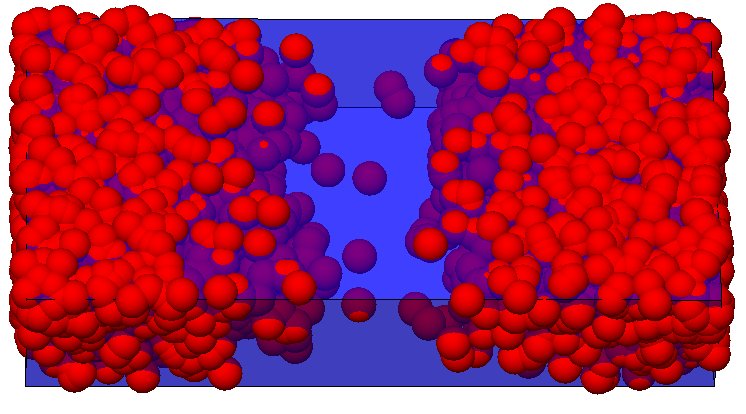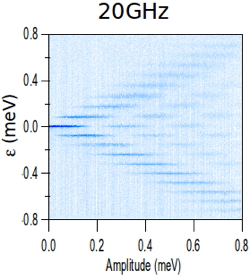 Single dopant control
Single dopant control
 Simulation of the doping with discrete As dopants, represented by red spheres of radius the mean bare Bohr radius (2.2nm). The very few isolated dopants in the center are responsible for the large off-state current observed in some samples.
Simulation of the doping with discrete As dopants, represented by red spheres of radius the mean bare Bohr radius (2.2nm). The very few isolated dopants in the center are responsible for the large off-state current observed in some samples.
We have developped a robust design for single electron transistors based on gated silicon nanowires (see this page), fabricated within a state-of-the-art CMOS fabrication facility, on 200 and 300mm wafers (collaboration with CEA-Leti). Recently we have designed shorter samples, with a dedicated doping scheme and doping architecture, in order to study single dopants which have intentionally diffused into the channel. Resonant tunneling through this single donor state is observed [1, 2] and the ionization energy (ground state) of this dopant has been measured.
See also this other page by clicking here.
[1] Pierre M, Wacquez R, Jehl X, Sanquer M, Vinet M, Cueto O
Single-donor ionization energies in a nanoscale CMOS channel.
Nature Nanotechnology, 2010, 5: 133-137
[2] Golovach VN, Jehl X, Houzet M, Pierre M, Roche B, Sanquer M, Glazman LI
Single-dopant resonance in a single-electron transistor.
Physical Review B, 2011, 83: 075401
 Two-dopant control
Two-dopant control a) Schematic of the sample with As dopants in the source and drain in blue. For positive substrate bias and negative front gate voltages the electrons flow near the buried Si/SiO2 interface in the constriction between the front gates. Two P donors (P1, P2) are drawn in red in this region.
a) Schematic of the sample with As dopants in the source and drain in blue. For positive substrate bias and negative front gate voltages the electrons flow near the buried Si/SiO2 interface in the constriction between the front gates. Two P donors (P1, P2) are drawn in red in this region.
b) spectroscopy at Vd=16mV showing the ground state (base of the triangles) and the first excited state line at 10meV.
The next step beyond single-dopant control is the ability to control a single charge over two, coupled dopants. This has been achieved recently for the first time [1], allowing to measure the valley-orbit splitting (first excited state) of a dopant. The high value we have found is affected by the environment and quantum effects, but remains very large (10meV). This is very encouraging for using two coupled donors for performing quantum manipulations.
See also this other page by clicking here.
[1] Roche B, Dupont-Ferrier E, Voisin B, Cobian M, Jehl X, Wacquez R, Vinet M, Niquet YM, Sanquer M
Detection of a large valley-orbit splitting in silicon with two-donor spectroscopy.
Physical Review Letters, 2012, 108: 206812
 Two-atom electron pump
Two-atom electron pump
 Experimental data of the pumped current in the non-adiabatic regime. All the characteristic features observed in this figure is explained by our model taking into account finite tunnel rates to the leads and a Landau-Zener transition between the two dopants.
Experimental data of the pumped current in the non-adiabatic regime. All the characteristic features observed in this figure is explained by our model taking into account finite tunnel rates to the leads and a Landau-Zener transition between the two dopants.
We have realized electron pumping through two phosphorus donors in series implanted in a silicon nanowire. While quantized pumping is achieved in the low frequency adiabatic regime, we observe remarkable features at higher frequency when the charge transfer is limited by the different tunneling rates. The transitions between quantum states are modeled involving a Landau-Zener transition, allowing to reproduce in detail the characteristic signatures observed in the non-adiabatic regime. This work has been done in collaboration with Roman Riwar and Janine Splettstoesser in Aachen (RWTH) [1].
[1] Roche B, Riwar RP, Voisin B, Dupont-Ferrier E, Wacquez R, Vinet M, Sanquer M, Splettstoesser J and Jehl X
A two-atom electron pump.
Nature Communications, 2013, 4: 1581
 Coherent, Landau-Zener-Stückelberg interferences
Coherent, Landau-Zener-Stückelberg interferences
 Coherent driving of the double-donor TLS. We observe sharply defined interference fringes.
Coherent driving of the double-donor TLS. We observe sharply defined interference fringes.
Electric control of individual atoms or molecules in a solid-state system offers a promising way to bring quantum mechanical functionalities into electronics. This idea has recently come into the reach of the established domain of silicon technology, leading to the realization of single-atom transistors (first paragraph of this page). Recently we have shown that we can electrically couple two donors, and induce coherent oscillations in their charge states by means of microwave signals. Gigahertz driving of this TLS results in a quantum interference pattern associated with the absorption or the stimulated emission of up to ten microwave photons. We estimate a charge dephasing time of 0.3 nanoseconds, consistent with other types of charge quantum bits. Here, however, the relatively short coherence time can be counterbalanced by fast operation signals (in principle up to 1 terahertz) as allowed by the large empty energy window separating ground and excited states in donor atoms. The demonstrated coherent coupling of two donors constitutes an essential step towards donor-based quantum computing devices in silicon [1].
[1] Dupont-Ferrier E, Roche B, Voisin B, Jehl X, Wacquez R, Vinet M, Sanquer M and De Franceschi S
Coherent coupling of two dopants in a silicon nanowire probed by Landau-Zener-Stuckelberg interferometry.
Physical Review Letters, 2013, 110: 136802